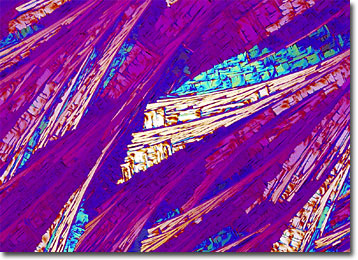Polarized Light Microscopy Digital Image Gallery
Estrone
Estrone is one of the three major hormones that chiefly influence the female reproductive system. This substance, along with estradiol and estriol, is often referred to as an estrogen.

Within the female body, estrone is primarily produced in the ovaries, but is also exuded in smaller amounts by the adrenal glands. In males, estrone and the other estrogens are generated in minor amounts in the testes. Generally, the estrogen most heavily secreted and most active in the body is estradiol, but this substance is soon converted to estrone when it enters the bloodstream. Estriol, on the other hand, is the estrogen primarily produced by the placenta in pregnant women. Together the estrogens, which are typically at their highest levels in the blood during ovulation, stimulate growth of the egg follicle, thicken the wall of the uterus, facilitate muscle contractions, and in lower animals, induce estrus. The hormones are also responsible for breast development and a number of other physical differences between males and females.
Estrone was first isolated in 1929 by American biochemist Edward Adelbert Doisy, who later isolated estriol (1930) and estradiol (1935) as well. These notable achievements were an important step towards the development of oral contraceptives, which are largely composed of estrogens. The reason that these hormones are effective for such an application is that they inhibit the pituitary glandís secretion of follicle-stimulating hormone and can, consequently, suppress ovulation. Synthetic estrogen is also commonly prescribed to menopausal women in order to lessen undesirable physical effects, such as hot flashes, caused by the bodyís hormonal changes and is sometimes used as a treatment for prostate cancer.
